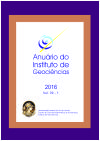Use of Different Satellite Sensors on Discrimination of Natural Targets
DOI:
https://doi.org/10.11137/2016_1_13_22Keywords:
Onda Verde city, Remote sensing, Geothecnologies, Orbital imagesAbstract
The particularities of the remote sensing instruments, even when they have the same characteristics, made the images generated, different among themselves. With that in mind, the goals of this work were to analyze the applicability and the limits of detection in the identification of natural targets in different satellite images. The area of study is located in Onda Verde in the state of São Paulo. The natural targets were selected from the analyses taken of the images and in the field trip. The images chosen presented the best contrast with the surroundings and easy to locate in the satellite images. For the digital processing of them the free software gvSIG was used. In this study, data of the mean spatial resolution satellite images were used such as Landsat-5, CBERS-2B e IRS-P6, available in the public domain database of the INPE (Instituto Nacional de Pesquisas Espaciais) and images of high spatial resolution of the satellites RapidEye and WorldView-2. In the mean spatial resolution sensors, the smallest spatial resolutions of the TM and LISS-3 sensors didn't interfered the visualization of the spectral targets analyzed, since the CCD have the higher spatial resolution, it wasn't possible the identification of the selected targets. The high spatial resolution images RapidEye and WorldView-2 showed great levels of details for the land cover, hence the high radiometric resolution of these satellites.Downloads
Published
2017-02-15
Issue
Section
Article
License
This journal is licensed under a Creative Commons — Attribution 4.0 International — CC BY 4.0, which permits use, distribution and reproduction in any medium, provided the original work is properly cited.
















 Except where otherwise noted, content on this site is licensed under a license
Except where otherwise noted, content on this site is licensed under a license 